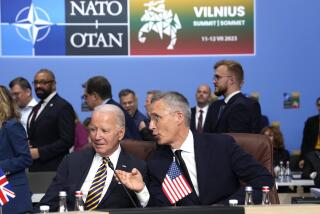Ex-Adversaries in Cold War Start Joint Military Exercises : Europe: U.S. troops join soldiers from 12 nations on the Continent for maneuvers in western Poland. Russia is conspicuous by its absence.
- Share via
BIEDRUSKO, Poland — Soldiers from the United States and 12 European countries on both sides of the former East-West divide met on a remote training field here Monday, opening what military leaders called a historic era in post-Cold War cooperation.
Onetime enemies from NATO and the now-defunct Warsaw Pact stood shoulder to shoulder for the first time on the soil of a former East Bloc nation in the first of several military exercises to be held this year under the Atlantic Alliance’s new Partnership for Peace program.
“I never thought I would be in Poland with NATO except to fight the Russians,” said German army Capt. Lothar Pfenning, who grinned in disbelief as military bands blasted the national anthems of the 13 armies in this tiny town near Poznan in western Poland.
No Russian troops took part in the military maneuvers, but NATO officials said they were absent only because Russia joined the Partnership for Peace program after invitations to the event had been extended. Russian army Lt. Col. Alexander Strelsky, who attended as an observer, said his country did not participate because it recently hosted bilateral training maneuvers with the United States.
“You can’t do everything at one time,” Strelsky said.
But the Russian absence was conspicuous, as was Strelsky’s refusal to answer questions about the political dimensions of the maneuvers. Russia has made no secret of the discomfort it feels about NATO courting its former East Bloc client states. It is particularly sensitive about military activity in Poland, which historically has served as a buffer between Russia and Germany.
Poland, one of the most eager NATO aspirants, has been equally insistent that Russia not be allowed to interfere with its integration into Western institutions, including NATO.
“Poland participated in World War II along with the Allied forces as a winner but, because of the political solution that came after the war, fell under the influence of the Soviet Union,” said Polish Prime Minister Waldemar Pawlak. “These military exercises taking place 50 years after the end of World War II bring a new dimension to European cooperation.”
In opening the five-day exercises, U.S. Gen. George A. Joulwan, NATO’s supreme Allied commander in Europe, said the meeting of Eastern and Western forces marked a new chapter in European history. Joulwan said the once-hostile armies should start acting as “the vanguard” of a peaceful Continent “from the Atlantic to the Urals,” language clearly intended to comfort the Russians.
“Five years ago, we traced each other across an Iron Curtain as adversaries,” Joulwan said. “Today we come together to train as partners and friends, dedicated to building a Europe whole and free, democratic and at peace.”
Poland and other East European countries view the weeklong exercises as an important step toward eventual NATO membership, even though NATO has offered no such assurances. The meeting was originally intended as a bilateral Polish-American maneuver but was expanded to include NATO and the Partnership for Peace countries at the urging of the Poles, who wanted the distinction of being the first country to host such an event.
NATO, meanwhile, was eager to show off its popularity among its former enemies, especially on the territory of one of them.
“We wanted to make sure the first exercise was in Eastern Europe so it didn’t look like NATO was spoon-feeding the Partnership for Peace program to the Eastern countries,” said one NATO official who asked not to be identified. “This way it is a politically significant event.”
Indeed, although billed as a military exercise, the assembly of 920 soldiers from six NATO and seven former Warsaw Pact countries was mostly a political event played out before hundreds of journalists and political leaders from Poland and across Europe.
Organizers interrupted maneuvers for television cameras and on-the-spot interviews, although the public relations extravaganza got sticky several times when rifle-toting soldiers mistook media convoys for military decoys and ordered them off the road.
The exercise included no mock battles, concentrating instead on peacekeeping activities envisioned under the Partnership for Peace program. NATO foreign ministers endorsed it in January as a way to integrate former Eastern adversaries and nonaligned European countries into NATO peacekeeping operations, with the possibility of other cooperation. Twenty-two countries have signed partnership agreements.
In the course of the week, soldiers will sightsee in Poznan, attend rock concerts, lift weights, go to church and compete in sports events, but they will participate in only one battle exercise: a shooting contest at a firing range.
“It is mostly a dog-and-pony show,” said U.S. Army Staff Sgt. Robert Fox. “This is very low-stress compared to the way we normally train.”
But Fox and other soldiers--from the United States, Britain, Bulgaria, the Czech Republic, Denmark, Italy, Germany, Lithuania, the Netherlands, Poland, Romania, Slovakia and Ukraine--said the exercises had already given them a chance to meet other soldiers in a noncombat environment. Many said they had made good friends among armies on the other side of the former Cold War divide, exchanging gifts and drinking beer into the late evening.
“We are soldiers here and not politicians, and that makes it easy,” said Bulgarian army Maj. Angel Dimitrov. “The last person who wants to go to war is a soldier.”
More to Read
Sign up for Essential California
The most important California stories and recommendations in your inbox every morning.
You may occasionally receive promotional content from the Los Angeles Times.













